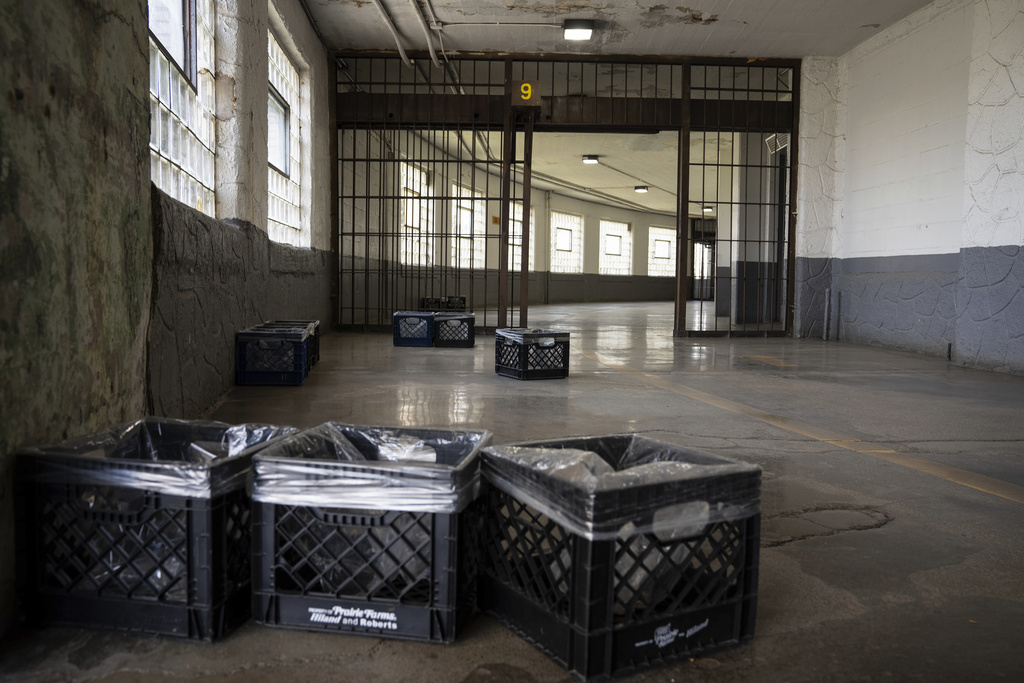
SPRINGFIELD, Ill. (AP) — When film star James Stewart went on location in 1948 at Stateville prison’s notorious roundhouse while portraying a Chicago newspaper reporter whose work freed a wrongly convicted killer in “Call Northside 777,” the lockup had already been standing nearly a quarter of a century.
Now, 76 years and hundreds of millions of dollars of neglected repairs later, the Illinois prison home of infamous killers Leopold and Loeb and Richard Speck, and the site of John Wayne Gacy’s execution, is shutting down.
The Illinois Department of Corrections already has begun transferring inmates from the facility in the Chicago suburb of Crest Hill, a contentious decision bolstered by a federal court order last month.
Last spring, Gov. JB Pritzker’s administration announced a $900 million plan to replace Stateville, which opened in 1925, with a state-of-the-art facility on adjacent, state-owned land. The campus also could see a new women’s prison. Supplanting the deteriorated Logan Correctional Center in central Illinois is part of the proposal; it might move to the Stateville campus. Completion could be three to five years away.
But that’s about all the administration has said. There has been no disclosure of a design plan; no timeline for demolition, groundbreaking or even deciding what will happen to prison staff.
Nonetheless, Corrections officials’ decision to shutter the facility this month was made long before the court decision made it inevitable. Ruling in a decade-old lawsuit challenging the health and safety of Stateville’s environment, U.S. District Judge Andrea Wood on Aug. 9 ordered most of the prison’s 430 inmates to be evacuated by Sept. 30.
“The primary reason for the facility’s closure during the rebuild is to address serious safety and security concerns posed to those who work and live in Stateville,” acting Corrections Director Latoya Hughes told a legislative review panel in June. “This is not just a matter of preference but a necessary step to ensure safety, efficiency and the fulfillment of our rehabilitative mission.”
Employees and service providers, such as institutions that supply a variety of educational courses and social programs to inmates, want Stateville to stay open while its replacement is constructed to avoid disruption to services or destruction of a tightly knit and highly experienced staff.
The prison is behind on maintenance by $286 million, according to a long-range capital needs study released in May 2023. It identified $12 million in immediate upgrades, but Hughes said that “grossly underestimates the full spectrum of urgent needs.” Wood’s court order focused on falling chunks of concrete, bird feathers and feces and foul-smelling tap water.
The ramshackle F-House, a circular unit with cells around the perimeter and a guard tower in the middle, was closed in 2016 — the last of the nation’s roundhouse prison housing units — although it was briefly reopened during the COVID-19 pandemic to put more space between inmates. F-House and other buildings no longer in use are part of the backlog of repairs, but they still require maintenance, Hughes said.
It doesn’t make sense to pay for rehabilitation while also preparing for a huge outlay on a new facility. What’s more, much of the work would require moving inmates anyway, Hughes said.
But it doesn’t make sense to state Sen. Rachel Ventura that the department has not followed through on resolving concerns she and other lawmakers raised during public hearings in June — she said in one case, an inmate promised a continued education course no longer has access post-transfer. The Joliet Democrat said she has asked repeatedly for updates but is told there’s no new information.
“If they’re going to shut it down (Sept. 30), well, what are you doing with it? Are you transferring furniture out of there? Are you getting out a demo plan? Are you getting an environmental study done?” Ventura said. “These would be the next logical steps, but to have nothing, no response from DOC on this — again, highly concerning.”
An email was sent to Corrections’ spokesperson, followed up by a telephone message, seeking comment on activity at Stateville: timelines for closure, demolition and groundbreaking, and what measures are necessary after inmate evacuation.
The hearings in June before the bipartisan, bicameral legislative Commission on Government Forecasting and Accountability, were understandably packed with American Federation of State, County and Municipal Employees members jittery about not just losing their jobs but breaking up collegial, cooperative staff environments at Stateville and Logan.
Stateville has 939 staff members, including 676 who provide security. Hughes noted that Corrections Department understaffing works in their favor. In June, she said the agency had 1,000 vacancies within 63 miles (101 kilometers) of Stateville, including at facilities that will remain open on the Stateville campus. There are 500 vacancies to the south at the larger — and older — Pontiac Correctional Center and 168 at Sheridan prison to the west. When Stateville reopens, its former employees will have first dibs on returning.
But many employees have a long commute to Stateville. Charles Mathis drives 45 minutes from his south Chicago home. A transfer to Sheridan or Pontiac would mean a one-way trip of up to two hours, to say nothing of double shifts employees work once they get there because of staff shortages.
“That kind of commute round trip would take an enormous toll on my mind and body,” Mathis said. “It would take away from the precious time that I have with my family and friends. I speak for all my co-workers when I say that that may be nearly impossible to justify.”
Source: post
